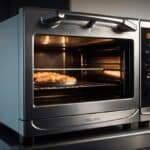When my self-cleaning oven starts to work its magic, it’s not just stains and grime it’s attacking—it’s also my sense of smell. I’ve noticed a distinct smell that fills my kitchen, sometimes even spreading to other areas of my home.
The self-cleaning function is designed to heat the oven to high temperatures to burn off food residue, which can cause these potent odors. It’s a useful feature to save time and elbow grease, but dealing with the resulting smell can be a nuisance.
Table of Contents
Understanding the origins of this self-cleaning oven smell is key.
During the cleaning cycle, the oven reaches extremely high temperatures that incinerate leftover food particles. This process makes cleaning much simpler, as I only have to wipe away a bit of ash at the end. However, the trade-off is the strong, sometimes unpleasant, odors that arise.
Fortunately, there are ways to address and mitigate these odors to ensure a more pleasant experience when using the self-cleaning feature.
Understanding Self-Cleaning Ovens and Their Smells
Self-cleaning ovens utilize high heat to burn off food residues, which can sometimes result in a noticeable and unpleasant chemical smell. I will explain why these odors occur and how they can be managed effectively.

Common Causes of Odors
When I operate my self-cleaning oven, the high heat, which often exceeds 500°F (260°C), is designed to turn food spills and grime into ash. However, this process often releases various compounds that can cause a distinctive, sometimes unpleasant odor.
Common causes of these odors include:
- Residual Grease and Food Particles: These can emit smoke or fumes as they are incinerated, leading to a smoky or chemical smell.
- Heating Elements and Interior Coatings: Sometimes, the elements and coatings themselves can contribute to the smell when they are exposed to extreme temperatures.
It’s important to note that while the smell from a self-cleaning oven can be unpleasant, it is typically not dangerous. However, it’s essential to ensure proper ventilation to avoid breathing discomfort.
Steps to Fix and Prevent Odors
Dealing with odors from a self-cleaning oven requires attention before, during, and after the self-cleaning cycle. I’ll guide you through the specific actions you can take to mitigate these smells and maintain a fresh oven environment.
Before the Self-Cleaning Cycle
To prevent strong odors, maintenance is crucial.
I always start with removing oven racks and visible debris, like fallen food particles or excessive grease. This step is important because it minimizes the amount of smoke produced during the cleaning cycle.
I make a habit of regularly wiping up oven spills when they’re fresh to avoid them baking on over multiple uses.
- Remove oven racks: Clean them separately with warm soapy water or a paste of baking soda and water for tough spills.
- Wipe away loose debris: Using a damp cloth, I make sure to collect any food residues or crumbs.
During the Self-Cleaning Process

While the self-cleaning cycle operates at high temperatures to incinerate leftover food and spills, managing smells as they happen helps a great deal.
Placing a shallow dish of water inside and setting the oven to 350 degrees Fahrenheit for a brief period before starting the self-cleaning can help to loosen debris, as described on Mr. Appliance.
I also recommend:
- Maximizing ventilation: Ensure windows are open or the ventilation fan is on high.
- Using heat-resistant materials: If using any materials inside the oven, such as aluminum foil to catch drips, check they are designed to withstand high temperatures to avoid fumes.
After the Self-Cleaning Cycle
Once the cycle is complete and the oven cools down, I address any lingering odors.
If a smell persists, it indicates that not all residue was burnt away or there’s a need to neutralize the odor.
- Ventilate: I continue to keep the windows open or the fan running to help clear out any remaining fumes.
- Odor absorption: A bowl of vinegar or baking soda can absorb stubborn smells, as suggested by guides like the one on Tom’s Guide.
- Wipe down: Using a mixture of vinegar and water, I wipe down the oven interior to remove any ash residue.

Safety Concerns and Tips
When using a self-cleaning oven, safety is paramount. I’m aware that the process, while convenient, entails potential risks such as hazardous fumes and even fire hazards.
My aim is to equip you with knowledge to mitigate these concerns.
Potential Hazards of Self-Cleaning
Self-cleaning ovens function by reaching extremely high temperatures to incinerate food residue and spills. The primary dangers during this process can include:
- Fumes: The self-cleaning cycle can produce unpleasant odors and potentially harmful fumes, particularly from any plastic that may have melted inside the oven prior to cleaning.
- Fire Risk: There is a small but notable risk of fire if large pieces of food or grease are left in the oven during the self-cleaning cycle.
By removing oven racks and wiping away excess debris before engaging the self-clean feature, I can reduce the likelihood of smoke and fires.
Protecting Sensitive Groups
Certain groups, such as individuals with respiratory issues and pets, especially tropical birds, may be sensitive to the fumes generated by self-cleaning ovens.
To protect them, I follow these steps:
- Remove Pets: Keep pets, particularly birds, in a well-ventilated area far from the kitchen during the self-cleaning cycle.
- Ventilate: Ensure my kitchen is well-ventilated, with windows open and exhaust fans running, to disperse any fumes.
- Presence: I never leave my home while the oven is self-cleaning. Staying nearby allows me to respond quickly if a smoke alarm goes off or if there is an unexpected issue.
Professional Maintenance and Additional Solutions
Maintaining a self-cleaning oven in peak condition and addressing obnoxious odors requires a blend of professional support and practical home remedies.
When persistent bad smells occur, or when I suspect something might be wrong with the appliance’s function, I consider the expertise of professionals like Mr. Appliance and explore additional cleaning methods that complement the self-cleaning feature.

When to Call a Professional
I call a professional when I notice a severe burnt smell that doesn’t dissipate after several self-cleaning cycles, or when I see smoke that hints at a potential malfunction.
For gas ranges, it’s particularly crucial to consult a specialist if I suspect gas is contributing to the bad smells, as this could indicate a leak, which is a safety hazard.
Regular maintenance by a certified technician can prevent the buildup of charred food and mitigate the chances of developing a stubborn, baked-in burnt smell.
Alternative Cleaning Methods
If I’m looking for a gentler option or for an additional cleaning after the self-cleaning process, steam cleaning is a practical choice.
Steam helps loosen debris, and it’s a method that aids in preserving the oven’s interior.
However, when tackling stubborn odors, I can also use natural deodorizers.
Placing a dish with a mixture of water and vanilla extract in the oven and allowing it to warm up can help neutralize unpleasant smells.
It’s important to ensure proper air circulation in the kitchen during any cleaning process to help clear out odors.









